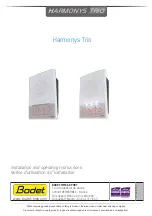
PD00D01KNX
– Product Handbook
Eelectron Spa
Via Claudio Monteverdi 6, I-20025 Legnano (MI), Italia
Tel +39 0331.500802 - Fax +39 0331.564826
[email protected] www.eelectron.com
C.F. e P.IVA 11666760159 - Capitale sociale: 800.000,00 interamente versato
Tribunale di Milano 359157-8760-07 - CCIAA Milano 1486549
PD00D01KNXFI00030103.DOCX
41/42
Determination of the control characteristic
The natural daylight drops off with increasing room depth. The controller can find the necessary
lighting intensity out from the reference measurement under the sensor (master) from measured
density values under the up to five lights. The determination of the five (5) density values must be
carried out at daylight.
Example:
Being brightness distribution of the daylight found out with a LUX metre of the density values
among the five lights like into Fig. 9 after room depth of Fig.9 represented for the configuration of
the control characteristic. The measurements are typed in ETS as a parameter "measured LUX
value position A, ..., E". At the same time, the position of the brightness sensor has to be indicated
here "to position A".
Note:
This kind of calibration requires sufficiently natural daylight and no artificial light. The determination
of the control characteristic is presupposed at the use of parameter "start value". The calculation
works all the better the bigger the measurements are. The regulation needs only the relationship of
the density values since these are standardized.
Determination of characteristic of used lights in the room
The light distribution is in the room of importance besides the light distribution in the room depth for
an efficient constant light regulation by the radiation characteristic of the lights used. This can be
found out at darkness without natural daylight. The inquiry can be started by an initial instruction
"1" on the communication object 71. An automatic regulation is therefore possible during the
darkness or not use of the room by time switching command during the after-hours. During the
procedure the lights are steered for with up to 15 predefined density values. The accompanying
brightness is measured in terms of the brightness sensor. A successful regulation is confirmed by
the shining of all lights with 50% brightness at the end. In the case of a fault these shine with
minimal brightness (approx. 6%). The 15 measurement results can be recorded and evaluated if
necessary with the ETS group monitor.
Fig. 9 Natural daylight drops off with increasing room depth


































